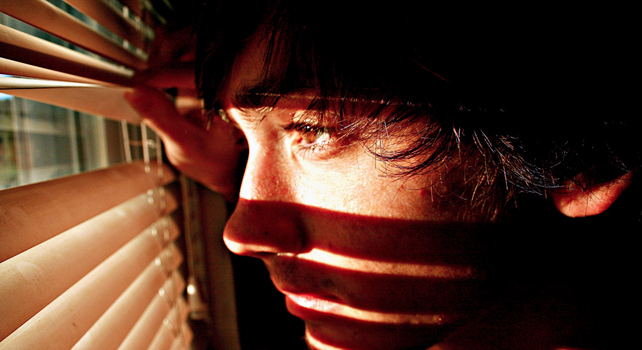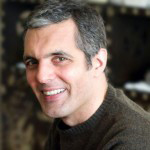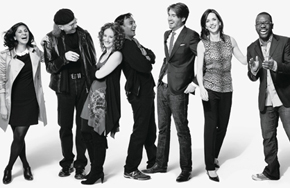Whether working in bronze, paint, or living cells, bioengineer Stephen Redenti takes the search for truth, beauty--and vision--seriously.

Stephen Redenti is an assistant professor of molecular, cell, and developmental biology at the City University of New York whose lab does cutting-edge work in stem-cell engineering with the aim of helping blind people see. He spent his post-collegiate years as a struggling artist--casting bronze crucifixion sculptures, painting sea life, and caring for lab pigeons--typical, eclectic, young adult stuff. Difference is, Redenti parlayed the ideas and skills he picked up during his wilderness years into a tool kit he still uses to actualize his vision of ... giving others vision.
FAST COMPANY: You’ve had a pretty roundabout path to stem-cell engineering.
 STEPHEN REDENTI: I got a B.A. from a state college in Connecticut. I spent too many years and graduated with a double major in sculpture and biopsychology. After graduation, I lived in New Haven and apprenticed with a neoclassical sculptor, John Saunders, and was a research assistant in a pigeon behavioral lab. My days were split between the lab and sculpture. When I was 26 and 27 I thought that was exciting --but neither really helped me pay the rent.
STEPHEN REDENTI: I got a B.A. from a state college in Connecticut. I spent too many years and graduated with a double major in sculpture and biopsychology. After graduation, I lived in New Haven and apprenticed with a neoclassical sculptor, John Saunders, and was a research assistant in a pigeon behavioral lab. My days were split between the lab and sculpture. When I was 26 and 27 I thought that was exciting --but neither really helped me pay the rent.
Serendipitous events led me to working with Saunders. His girlfriend was in a class with me. We met and we liked the same music, and he offered me an apprenticeship. He’s probably the best neoclassical sculptor I’ve ever met. He worked in bronze, doing lost-wax casting--at the time, he was building crucifixion scenes for monasteries throughout the world, and some commissions. Now he’s the director of monument preservation in New York City.
At that age I was just pursuing what was genuinely interesting to me. My sculpture was informed by my research in behavioral neuroscience. The same question existed in neuroscience as existed in sculpture--the basic question is, what is the nature of mind? I think I was asking more metaphysical questions when I was younger--luckily we stopped that! But there was always this overlapping of evolutionary theory and theory of the mind, and tying that into the aesthetics of sculpture. Somehow or other, it was all manifested in the physical structure of the body and the brain.
That’s pretty heady stuff. Were you reading things that helped you make those connections?
I was influenced by E.O. Wilson--he’s the father of social biology. I also liked Stephen Jay Gould. I was also reading Deleuze and Guattari, the heavy, conceptual reading you have to do as an art student. And Nietzsche and Freud. You find a lot of parallels when you’re a student and you’re bouncing between classroom and studio art everyday. To me there were more parallels than differences at that point.
So how did you get interested in the science of vision and decide to focus more on that side of your career?
I kind of left it to probabilistic events. I finished my bachelor’s degree in 1996, and started my PhD in 2001. After working with John Saunders for a few years, I’d traveled to Chicago and lived with some painters and made paintings of deep-sea life as a metaphor of consciousness. I was exhibiting and probably could have continued down that road, but I think I had some romantic notions about getting discovered without self-promotion. So I kind of flipped a coin and applied to an MFA program in sculpture at the School of Visual Arts and to a PhD program in neuroscience at CUNY. I wasn’t accepted at the sculpture program for some reason.
About Generation Flux Pioneers of the new (and chaotic) frontier of business Flagship Fluxers, Photo: Brooke Nipar
Flagship Fluxers, Photo: Brooke Nipar
In our February 2012 issue Fast Company Editor Robert Safian identified a diverse set of innovators who embrace instability, tolerate--and even enjoy--recalibrating careers, business models, and assumptions. People like author/Onion digital media maverick Baratunde Thurston, Greylock Data Scientist DJ Patil, Microsoft Senior Researcher danah boyd, and GE's Beth Comstock. This series continues to explore the new values of GenFlux. Find more Fluxers here. And tweet your contributions using #GenFlux.
In Chicago, I was also working for a place called Recording for the Blind and Dyslexic, helping support myself by reading textbooks onto audiotapes. Later, when I did my PhD, it was in visual neuroscience. That wasn’t something I planned either, and I’ve been working on that for 10 years now.
What happened was a professor named Richard Chappell who’d taught one of my neuroscience classes invited me to work in his lab, and he happened to be working on the biochemistry of the retina. He also had a summer lab doing marine research in Cape Cod. He was someone I could talk to easily. He was a nuclear engineer who built propulsion systems for submarines before he became a neuroscientist. He was kind to me. I wasn’t particularly interested in visual neuroscience, but a lot of consciousness is tied to visual neuroscience. If a neurobiologist wants to understand what consciousness is, very often they’ll look at visual consciousness because it’s a kind of consciousness that can be measured. I just took advantage of the opportunity, and it wasn’t something I could have predicted.
For your post-doc work, you were working in one of the top bioengineering labs in the country. Did your background in sculpture help there? Did you see things differently than your colleagues?
I worked with a scientist named Michael Young, in the ophthalmology department at Harvard, and he had an ongoing collaboration with Robert Langer at MIT. For two or three years I worked between the ophthalmology department and the bioengineering lab at MIT with Langer. That’s where we were engineering tissue. It was very primitive, and not very successful--but very creative work. At that level, I kind of had creative license to work with the engineers to design micro-scale biodegradable landscapes for stem cells to grow on. That was not unlike the creativity involved in sculpture.
When you’re building a three-dimensional sculpture, you have to build the architecture to support the clay. Then you have to build devices to support the sculpture in progress--little scaffolds, levies, pulleys. I think that kind of found-object resourcefulness came in handy at the stem-cell laboratory. One of the first things we had to build was a tool to inject a scaffold material into the back of the eye. The boss and a couple of the other scientists had been struggling to find a way to make something that would work. I think in about 15 minutes I had a little device made out of scrap parts that were lying around the lab--a little push device where you could load the polymer with stem cells into a tube and use a plunger with a little stick attached to push that into the eye. That resourcefulness, a way of seeing how disparate parts could come together to form a functional whole--I think that came from sculpture a little bit.
The creative design of three-dimensional polymers is maybe more interesting. The idea is that you build these biodegradable structures, grow stem cells on them, and then somehow introduce that stem-cell/polymer composite to the area where you want to create more tissue. The creative aspect is you want to create a biomimetic structure--something that mimics biology. In Langer’s lab, we made a very elastic polymer almost as soft as retinal tissue. I helped design a micro-scale, hollow, cage-like structure for the stem cells to grow on, which could be folded and implanted into the eye. We engineered and tested that and published a paper on it.
How does your work today build on that?
That kind of tissue engineering using polymers is good if the tissue you want to make isn’t that complicated. But in more complicated tissue--the brain and the retina are probably the most complicated--polymers are more of an obstacle because you’re putting biodegradable plastic into a highly layered structure. So we’re trying to find ways to get the retinal cells to assemble on their own, to generate their own scaffolds and three-dimensional structures using biochemistry or electrical stimulation.
Do you think biomedical research would benefit from having more “artistic types” working on these kinds of problems?
In terms of creativity, I’ve seen some real advantages to having been an artist. Especially in something as cutting-edge as tissue engineering, I think that an active imagination is very valuable in moving the field forward. But it’s a big step to take between imagining some great experiment or some great phenomenon and turning it into reality. People have a thousand bright ideas a day, and maybe one in a thousand turn out to be something substantial. The most important thing is harnessing that imagination to generate substantial research questions.
So, is a sense of beauty useful in science?
I think the desire to articulate this kind of beauty you observe and experience as a scientist or an artist is comparable. What I was trying to do as an artist was to articulate the beauty of reality, of perception, of experiencing life. I also have this similar desire to articulate the beauty of what the consciousness of a cell might be, or how the intricate intelligence that guides life manifests itself. We try to put one piece of the puzzle together at a time, but the total phenomena of a living organism or even a functioning cell is still more mystery than scientifically defined. That is poetically still very motivational to me--it’s something I’ve carried with me. Some of the big questions I was trying to answer as a kid, I’m getting to them now.
[Image: Flickr user r.f.m II]